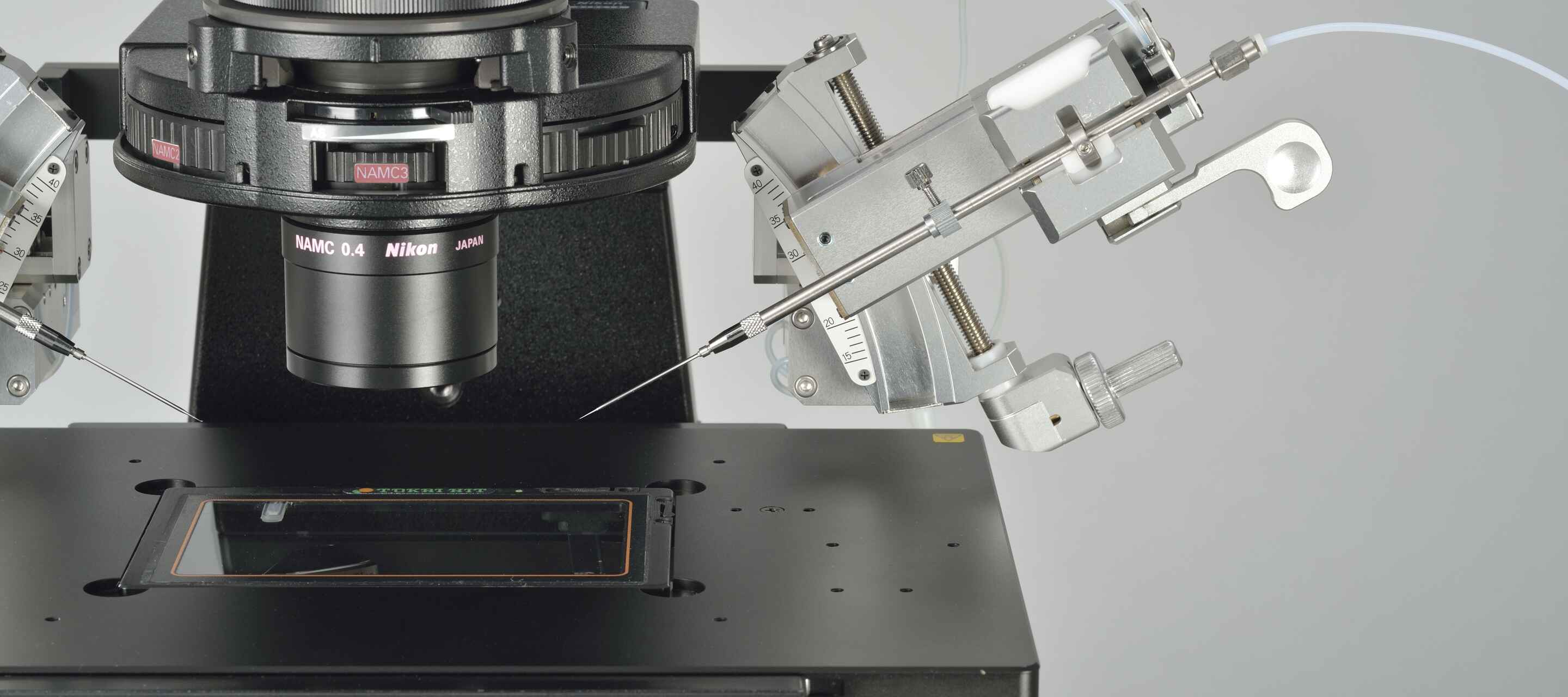- ko Change Region
- Global Site
마이크로인젝션

Microinjection is a method for mechanically injecting cells, genetic material, peptides, drugs, or other exogenous agents directly into cells or tissues using a very small pipette. Conversely, material may also be removed from the sample (e.g., enucleation of cells). Microinjection has numerous research and clinical applications, including transfection of cells via DNA injection, fertilization by intracytoplasmic sperm injection (ICSI), introduction of genetically engineered embryonic stem cells into a blastocyst, and more.
Products for 마이크로인젝션
The ECLIPSE Ti2 Series of inverted microscopes are suitable for various microinjection applications. Micromanipulator/microinjector options from different third-party manufacturers are compatible with the Ti2. Intermediate magnification can be applied within the Ti2 microscope body (1.5X and 2.0X available) for detailed imaging using low magnification objective lenses. Various long working distance condenser options are available that don’t interfere with micromanipulation equipment.
The ECLIPSE Ts2R and Ts2R-FL inverted microscopes can also be equipped for microinjection, but feature a more compact body that fits well in biosafety cabinets and other tight spaces. The Ts2R-FL model additionally provides widefield epifluorescence using built-in LED light sources.
The SMZ25 and SMZ18 stereo microscopes can also be equipped for microinjection work. The SMZ25 features a 25:1 zoom range and the SMZ18 an 18:1 range, making detailed visualization of single cells possible.
●: included, ⚬: option
| ECLIPSE Ti2 Series Inverted Microscopes |
ECLIPSE Ts2R and Ts2R-FL Inverted Microscopes |
SMZ18/SMZ25 Stereomicroscopes |
|
|---|---|---|---|
| Micromanipulator Compatibility | yes | yes | yes |
| Camera Integration | yes | yes | yes |
| Illumination Source | LED or Halogen | LED | LED or Halogen |
| Thermal Control Availability | yes | yes | yes |
| Supported Contrast Techniques | ECLIPSE Ti2 Series | ECLIPSE Ts2R and Ts2R-FL | SMZ18/SMZ25 |
| Brightfield | yes | yes | yes |
| Darkfield | yes | no | yes |
| Differential Interference Contrast (DIC) | yes | yes | no |
| Widefield Fluorescence | yes | Ts2R-FL | yes |
| Nikon Advanced Modulation Contrast (NAMC) | yes | yes | no |
| Nikon Emboss Contrast | no | yes | no |
| Oblique Coherent Contrast (OCC) | no | no | yes |
| Phase Contrast | yes | yes | no |
| Spindle Observation | no | yes | no |
| Volume Contrast | Ti2-E | no | no |
Discussion of 마이크로인젝션
The importance of system stability for microinjection
Microinjection is a precision task where sub-micrometer level differences in position can make the difference between success and failure. For example, transfection by microinjection of cells with DNA coding for a given construct (such as a fluorescent protein fusion chimera) can have a different success rate depending on if the DNA was injected into the nucleus rather than the cytoplasm, where it is vulnerable to DNase enzyme activity.
Nikon’s ECLIPSE Ti2 and ECLIPSE Ts2R series of inverted microscopes, and SMZ18/25 stereo microscopes, are stable and vibration-resistant systems that can be used for microinjection work.
Environmental control for sensitive model systems
Biological models, whether they be single cells, tissues, or whole organisms, are sensitive to changes in environmental conditions. For this reason, a heating plate or similar apparatus is used to maintain the appropriate temperature and ensure the physiological integrity of your system.
Further Information on Microinjection and Microscopy
If you would like to learn more about Nikon solutions for micromanipulation/microinjection in the field of assisted reproduction technology (ART), please visit our page here.
Glossary
- Camera Integration
- Nikon provides a variety of camera options, including fast color and monochrome CMOS options.
- Illumination Source
- Illumination sources for transmitted light-based contrast techniques are most often either light emitting diodes (LEDs) or halogen lamps. LEDs are a bright, eco-friendly, and more energy efficient choice.
- Micromanipulator Compatibility
- Micromanipulation is required for control and positioning of micropipettes.
- Supported Contrast Techniques
- In addition to standard brightfield microscopy, it may be necessary to apply other contrasting techniques depending on the sample and application.
- Thermal Control Availability
- Temperature regulation is important for cell health. Nikon offers a variety of both stage-top and holding area thermal regulators.
